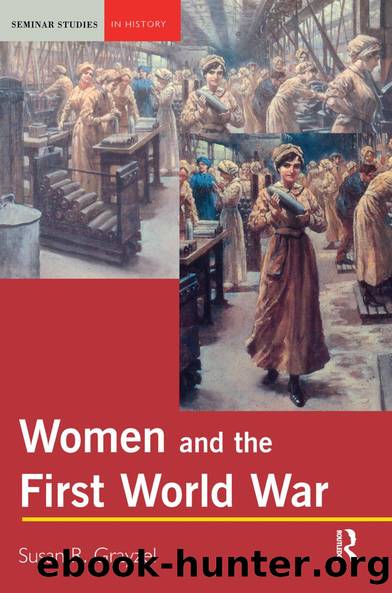Women and the First World War by Susan R. Grayzel

Author:Susan R. Grayzel [Grayzel, Susan R.]
Language: eng
Format: epub
Tags: History, Military, World War I, World, General
ISBN: 9781317875789
Google: E6MuAgAAQBAJ
Publisher: Routledge
Published: 2013-11-04T01:20:26+00:00
STRIKES, PROTESTS AND WAR-WEARINESS, 1917
By the winter of 1917, the war had reached a crisis point. Mutinies occurred across the Western Front, revolution struck Russia, protests about scarcities grew, and strikes threatened vital war production. All but the mutinies directly involved women, and all show how interconnected the lives of civilians and soldiers truly were.
France experienced a huge upsurge in both military and civilian unrest during the spring of 1917. While men mutinied in the war zone, strikes proliferated in the munitions factories in and around Paris, places where women workers were, by this time, in the majority. Often viewed by contemporaries and some historians as apolitical, the strikes were not, and striking women workers decisively linked complaints about wages and working conditions with criticisms of the war itself. Women initiated these work stoppages themselves, protesting against their low wages and proclaiming their desire for Sundays off. Most ominously for the government, when they took to the streets at the end of May 1917, they demanded that the government bring their soldiers home and send the presumed cowards â men avoiding the draft through factory work â to battle in their stead. That some 30,000 women had stopped producing armaments to demand money, their men and ultimately an end to the war gravely alarmed the government. It intervened by a combination of granting some concessions in wages and work and by getting rid of the âringleadersâ of the movement (Downs, 1993: 123, 130).
Even in non-belligerent European countries like Spain, the war affected the availability of food and fuel, and this in turn had an impact on the living standards of the working class. Shortages of items necessary for familiesâ survival prompted women to take collective action in various places, including Cordoba, Madrid, Alicante and most notably Malaga and Barcelona (Nash, 1995). In January 1918, reacting to the rising cost of bread and coal, groups of Barcelonaâs women took to the streets and its women factory workers went on strike. In the end, this wartime agitation was quelled only by the use of military force (Kaplan, 1982).
Economic hardship also severely affected women in Germany. Given the severity of the blockadeâs effects, German women, many of whom were now heads of households, had enormous difficulty in obtaining enough basic foodstuffs for themselves and their families. They became front-line soldiers of an economic war (Davis, 2000). Although they have too often been viewed as apolitical, it becomes clear that the food riots that occurred in German cities in 1917, like the strikes by women workers in France, had clear political implications. Protesting against the shortage of vital food stuffs such as potatoes, German women, especially âwar wivesâ, took to the streets (Daniel, 1997: 183â4). The strikes that began in Berlin metal-working factories and then quickly spread were accompanied by street demonstrations, but these kinds of protests themselves were not new. Vocal reactions occurred as soon as the shortages of food had become evident earlier in the war. What was different about 1917 was that it represented the final eroding of faith in the government as food scandals shocked civilians.
Download
This site does not store any files on its server. We only index and link to content provided by other sites. Please contact the content providers to delete copyright contents if any and email us, we'll remove relevant links or contents immediately.
The Radium Girls by Kate Moore(10938)
The Templars by Dan Jones(4203)
100 Deadly Skills by Clint Emerson(4102)
Rise and Kill First by Ronen Bergman(4036)
The Doomsday Machine by Daniel Ellsberg(3747)
The Rape of Nanking by Iris Chang(3540)
Killing England by Bill O'Reilly(3473)
Hitler in Los Angeles by Steven J. Ross(3459)
Stalin by Stephen Kotkin(3102)
12 Strong by Doug Stanton(3067)
Hitler's Monsters by Eric Kurlander(2746)
Darkest Hour by Anthony McCarten(2658)
Blood and Sand by Alex Von Tunzelmann(2618)
The Art of War Visualized by Jessica Hagy(2430)
Hitler's Flying Saucers: A Guide to German Flying Discs of the Second World War by Stevens Henry(2310)
The Code Book by Simon Singh(2228)
The Second World Wars by Victor Davis Hanson(2140)
Babylon's Ark by Lawrence Anthony(2080)
Tobruk by Peter Fitzsimons(2070)
